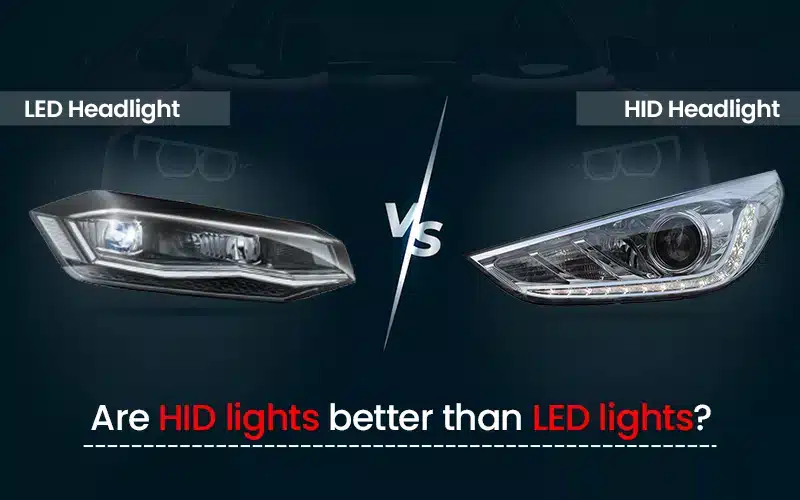Cart 74
74
My Cart

LED Headlights and HID Headlights are now in discussion in the headlight technology debate. More people are replacing their reflecting halogen car lights with LED and HID lights. Many drivers may do this at home using conversion kits, but even car manufacturers are installing them when building new vehicles.
Have you ever wondered whether High-Intensity Discharge (HID) or Light Emitting Diodes (LED) lights are superior? Although the brightness and range of the two light sources are comparable, they differ significantly. The location of your home, the time of day you drive, and the frequency of your nighttime travels are all relevant issues in this discussion.
When driving at night, upgrading to HID or LED Headlights can give you the extra vision you need to reach your destination safely. This guide can assist you in weighing your alternatives and choosing the HID or LED – Projector Headlights that will best suit your needs if you’re considering buying them for your car.
To assist you in deciding amongst them, we’ve put together the list below based on suggestions from industry professionals. Here is a side-by-side comparison of the two, followed by a detailed analysis of each technique individually.
Rare metals and gas are combined in HID headlights to produce a strong glow with a blue and white hue when the filament is heated. Many automakers use HID headlights, which are also referred to as xenon headlights. The following are some of the key advantages of using HID headlights:
The following table provides comparison information for LED and HID Headlights:–
| LED Headlights | HID Headlights | |
| Energy efficiency | Most efficient | Very efficient |
| Warm up | Instantaneous | Takes up to 30 seconds |
| Dimmable | Possible | No |
| Brightness | Above 2,000 Lumens | Around 3,000 Lumens |
| Price | Average | Average |
| Lifecycle | Over 5,000 Hours | 2,000 – 5,000 Hours |
| Color Temperature | 4,000-6,000K | 4,000-6,000K |
| Robustness | Shockproof & vibration resistant | Fragile |
LED Headlights, also known as light-emitting diode headlights, convey a current that causes a semiconductor to release photons, which in turn produce light. The following are some of the key advantages of adopting LED Headlights:
When selecting whether to install HID or LED Headlights on your car, keep these factors in mind.
The quantity of light that HID and LED Headlights produce is one of the most important things to think about. HID Headlights cover a wider area than LED headlights, but if they’re put incorrectly, they can reflect glare onto oncoming traffic, therefore it’s crucial to get them checked by a qualified expert.
If you’re upgrading from halogen bulbs, you’ll need to buy a conversion kit before installing, even though LED headlights are often smaller than HID headlights.
While LED and Projector Headlights last longer than conventional halogen bulbs, there are several obvious advantages for LED Headlights in this category. Compared to HID headlights, which have an average lifespan of up to 5,000 hours, they require replacement far less frequently due to their average longevity of more than 20,000 hours. Additionally, LED headlights are more durable.
Finally, think about the long-term advantages of changing your headlights as well as your available cash. Though slightly more expensive than HID headlights, LED headlights consume a lot less energy, are more durable, and need less upkeep. In the long run, this can help you save money.
Car lovers and drivers typically look for headlights that enhance the looks of their vehicles. Due to its potential effects on visibility and brightness, color temperature is also significant. While an LED conversion kit can be purchased in colors other than white, LED headlights can only be found in four different hues. For this reason, if you’re seeking a greater selection of color possibilities, think about HID headlights. Seven different color temperatures, ranging from red to white to purple, are frequently offered in HID headlights.
Determine what new Headlights are required. Consider using Halogen or HID lights if you commute more throughout the day. If you’re searching for a quick fix, another option is HID. We would recommend LEDs because of their brightness, ease of starting, and longevity for persons who drive at night. Think about where you are as well. Consider switching to LED lights if you live in a remote area with few streetlights. HID could be ideal if you live in a city.
Depending on the model brand, and year of your car, as well as the, HID or LED conversion kit you buy, there are several installation procedures for headlights. Even though many conversion kits are plug-and-play systems that you can set up in as little as 10 minutes, we advise carefully reading the installation instructions for your particular headlights before attempting DIY installation.
Conclusion
HIDs are a particular kind of light bulb that generates light through electrical interactions with metallic salts and a noble gas. They are less effective than LEDs despite being brighter than halogens. In conclusion, LEDs are superior to halogens in every way, although HIDs are still preferable.
Reference:
https://www.caranddriver.com/car-accessories/a38106796/hid-vs-led/